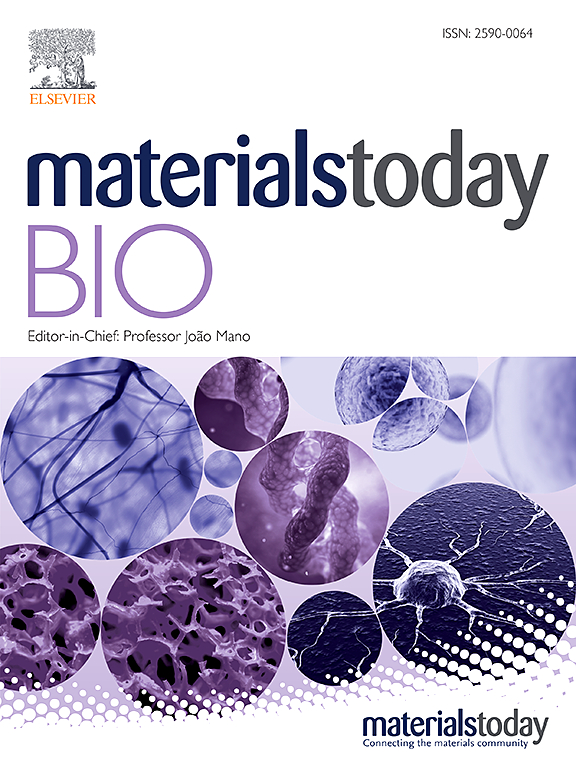Bifunctional MXene quantum dots-coated bimetallic Prussian blue analogues for sensitive sensing and accurate localization imaging of miRNAs in living cells
IF 8.7
1区 医学
Q1 ENGINEERING, BIOMEDICAL
引用次数: 0
Abstract
MicroRNAs (miRNAs) are involved in multiple cellular processes and play a critical role in clinical diagnosis. In-situ spatiotemporal imaging of miRNAs in living cells is tightly linked to the carcinogenesis and development of malignant tumors. Herein, we proposed a bifunctional nanosystem-based MXene quantum dots-coated bimetallic Prussian blue analogues (Co-Mn PBA@MQDs) to execute in-vitro sensing and intracellular imaging of miRNA in living cells. The 3D nanostructures of Co-Mn PBAs were regulated to slow down the coordination reaction rate by controlling the diffusion of metal clusters and ligand precursors, thereby anchoring MQDs as the carriers of DNA probes. The resulting Co-Mn PBA@MQDs nanoparticles with miRNA recognition ability exhibit excellent electrocatalytic and photoluminescence properties for target miRNA analysis. It reached miRNA detection limit of 0.37 fM (S/N = 3) with a wide linear range of 1 fM to 1 nM, and allowed distinguish family members without additional complex modifications. Meanwhile, DNA probe adsorbed on Co-Mn PBA@MQDs can provide delivery capacity for intracellular miRNA location, resulting in the in-situ monitoring and imaging of miRNA with deregulated expression levels in cancer cells. With these advantages, the developed strategy provides a paradigm for the rational design of the miRNA analysis system, which is expected to be widely applied to disease diagnosis and further theragnostic fields.

双功能MXene量子点包被双金属普鲁士蓝类似物用于活细胞中mirna的敏感传感和精确定位成像
MicroRNAs (miRNAs)参与多种细胞过程,在临床诊断中起着关键作用。活细胞中mirna的原位时空成像与恶性肿瘤的发生发展密切相关。在此,我们提出了一种基于双功能纳米系统的MXene量子点包被双金属普鲁士蓝类似物(Co-Mn PBA@MQDs),用于在活细胞中执行miRNA的体外传感和细胞内成像。通过控制金属团簇和配体前体的扩散,调控Co-Mn PBAs的三维纳米结构,减缓配位反应速率,从而锚定mqd作为DNA探针的载体。所得Co-Mn PBA@MQDs纳米颗粒具有miRNA识别能力,具有优异的电催化和光致发光特性,可用于靶miRNA分析。miRNA检测限为0.37 fM (S/N = 3),线性范围为1 fM ~ 1 nM,无需额外的复杂修饰即可区分家族成员。同时,吸附在Co-Mn PBA@MQDs上的DNA探针可以为细胞内miRNA定位提供递送能力,从而对癌细胞中表达水平失调的miRNA进行原位监测和成像。基于这些优势,该策略为合理设计miRNA分析系统提供了范例,有望广泛应用于疾病诊断和进一步的治疗领域。
本文章由计算机程序翻译,如有差异,请以英文原文为准。
求助全文
约1分钟内获得全文
求助全文
来源期刊

Materials Today Bio
Multiple-
CiteScore
8.30
自引率
4.90%
发文量
303
审稿时长
30 days
期刊介绍:
Materials Today Bio is a multidisciplinary journal that specializes in the intersection between biology and materials science, chemistry, physics, engineering, and medicine. It covers various aspects such as the design and assembly of new structures, their interaction with biological systems, functionalization, bioimaging, therapies, and diagnostics in healthcare. The journal aims to showcase the most significant advancements and discoveries in this field. As part of the Materials Today family, Materials Today Bio provides rigorous peer review, quick decision-making, and high visibility for authors. It is indexed in Scopus, PubMed Central, Emerging Sources, Citation Index (ESCI), and Directory of Open Access Journals (DOAJ).
 求助内容:
求助内容: 应助结果提醒方式:
应助结果提醒方式:


